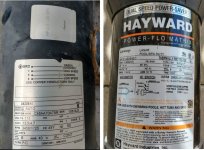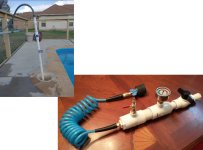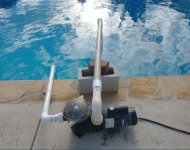It just started to rain here, so I can't do much outside today, but I'm going to set the stage for what's about to happen tomorrow.
In this first thumbnail pic, you see the basic concept of my suction line. The red line (original flex pipe) against the pool is what I cut and bypassed in August. It was pulling down and away from the skimmer about to break. The red line by our black dog (Buccee) is the last bit of remaining flex line on the suction side. I only cut & replaced what you see in yellow. After that work, I did a pressure test with my new manifold and it held water pressure at about 17 psi for about an hour while I inspected all joints for leaks.

This thumbnail simply shows the tail end of the suction line coming back to the pad. This is how it looks today after my pad re-do a few days ago. The pump, check valve, and 2-way are all new. I can re-measure, but it's about 45 ft from the skimmer to the pump with what I believe are about 8ea 90 degree elbows along the way.

Here are my two pumps. The Waterway Supreme on the left has worked great for about 10 years. I've taken it apart more than once to clean it up, give it a new shaft seal, etc. It always runs on low speed. Since day 1, it's always had a tiny bit of air under the lid, but nothing substantial, and nothing like a large gap of an inch or two until this season.
The pump on the right is my new Power Flo Matrix. I got it a couple years ago as a back up since it appeared to be identical to the Waterway. Just a couple cosmetic differences, but as I look closer at the HP ratings, I believe the Power Flo may be slightly weaker.

Tomorrow I will perform two types of water pressure tests using two different products I made. One is a simple staff design, the other a true manifold like you would buy online. The reason I'm doing both is because the staff tester screws into the skimmer port while the manifold has a blow-thru plug at the end and inserts a tiny bit more into the skimmer hole. I want to see if there's any difference at the entrance of the skimmer hole I could not ID during my static water dye test.

I have two theories:
1 - I have an air leak that was misdiagnosed or developed after successfully completing pressure testing in Sept.
2 - Both of these pumps are showing signs that they are not capable of pulling water adequately based on my pool configuration.
As an example, the Waterway shows much less air under the lid than the Power Flo, but it was still there. Why? Look at this pic below. As a test, I placed the Waterway pump right next to the pool and did not glue any fittings. It ran for 24 hrs absolutely air-free in the pot. Hummed as if it was off the showroom flow. But it only had a few feet of line and no filter restriction.

So why does this Waterway get air under the lid at 45ft away at the pad? Suction line leak? - maybe. But if it passes testing tomorrow, I can only assume the pump is showing signs of wear/age and perhaps not pulling as strong as when it was new in 2013. That might also explain why the new Power Flo Matrix is showing MORE air than the Waterway ever did because it appears to be a slightly weaker pump. Only later did I learn that both of these pumps are technically rated for AGP use. Yet another reason why I'm wondering if the pump(s) are showing signs that they are starving for water as opposed to an air leak. My system was originally installed with a check valve, and I suspect that's why they did it since these technically aren't self-priming pumps. I honestly never had a problem with the Waterway before, but now I am wondering if these pumps are struggling with the distance to pull the water.
I'll report back tomorrow after my pressure testing to see.







